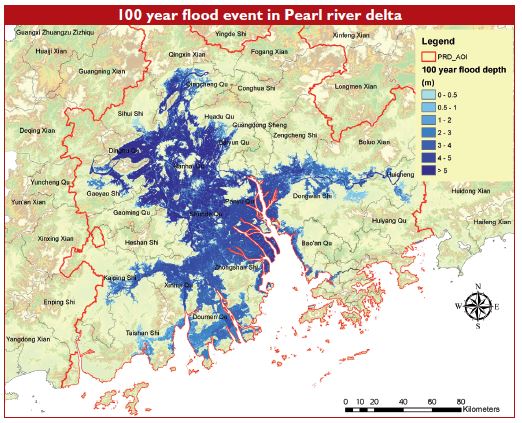Mr Adityam Krovvidi of Aon Benfield shares about two Realistic Disaster Scenario (RDS) models for parts of China and Vietnam that they have in their flood modelling arsenal to help insurers make more informed decisions on accumulation control, capital management, reinsurance purchasing and underwriting.
While seasonal flooding is typically prevalent across Asia during the monsoon seasons, there has been an increased focus on the peril following the historic floods in Thailand during 2011. That event, which caused economic losses in excess of US$47 billion (2014 US$), also had significant impacts on the insurance industry. The more than $16 billion (2014 US$) in insured losses made this the costliest flood event in recorded history and only further magnified the need for catastrophe models in the region.
Deadly and costly floods in Asia in 2014
2014 has been another year where deadly and costly floods have impacted vast areas of Asia. As of late October, the September floods across Kashmir in northern India and Pakistan had caused an estimated $18 billion in economic losses and made it the costliest natural disaster event of 2014 on the continent.
From an insurance perspective, the floods caused roughly $650 million in insured losses across the residential, commercial and agricultural lines of business. This will likely end up as Asia’s costliest insured flood disaster of the year.
China has also recorded multiple billion-dollar economic loss events this year, which has impacted dozens of provincial regions and caused a high loss of life. Other countries, including Vietnam, Cambodia, Laos, Indonesia and the Philippines have recorded similar costly flood-related events.
Realistic disaster scenario (RDS) models
According to Impact Forecasting, flooding events have caused more than $270 billion in economic damages throughout Asia since 2004 – this equates to 56% of all global flood losses. As population exposure and insurance penetration continue to grow, the threat of these losses becoming more costly increases every year.
These events have brought the issue of non-modeled perils and territories in Asia to the fore. A greater understanding of the potential impacts of flooding is important in developing appropriate mitigation and risk management strategies and importantly risk transfer capacity.
This was the impetus for focused model development in Asia Pacific through Impact Forecasting and the subsequent development of the probabilistic Thailand flood model in 2012. The team has developed a range of realistic disaster scenario (RDS) models for various perils to further bridge the coverage gap and offer an immediate solution as a stepping stone for more in-depth probabilistic models.
Two RDS models developed for parts of China and Vietnam
In relation to flood, Impact Forecasting has considered the peak exposure zones in emerging economies with growing insurance penetration and where flood hazard will drive the probable maximum loss (PML). As part of this process, RDS models have been developed for:
• China: The Pearl River Delta in Guangdong province, one of the most densely urbanised regions in the world and a key economic hub, and rainfall induced surface flooding in Shanghai.
• Vietnam: Ho Chi Minh City in the South on the River Saigon and Hanoi Province in the North by the Red River.
These are the first commercially available RDS models in Asia. Extending the purpose of RDS beyond the usual stress testing, the models are provided with multiple scenarios along with their hazard/event return periods.
Modelled footprints for key historical events like 2008 Hanoi flood and 2013 Typhoon Fitow are also provided as realistic scenarios for “as-if” analysis. The models are available on Impact Forecasting’s transparent and customisable loss calculation platform, ELEMENTS. This helps insurers make more informed decisions on accumulation control, capital management, reinsurance purchasing and underwriting through:
• detailed modelling for hazard and vulnerability including uncertainty;
• industry exposures and losses by line of business; and
• ability to run residential, commercial, general industrial, industrial estates and engineering portfolios.
Each of the scenarios is scientifically defined to qualify for the descriptors of “realistic” and “stress testing”. For example, the forecasted flows in rivers are computed from the historical data maintaining the spatial correlations, and high tide boundary conditions are taken at the river mouths while generating flood maps.
Data, software and expert insight are at the heart of these models to bring the necessary quality. All efforts were engaged to collect the most comprehensive data on flood hazard and defences through field surveys, liaison with government departments and investment in high quality data. For example digital terrain data in Vietnam has highest resolution of 5m x 5m. Flood inundation maps are generated by 2D hydrodynamic analysis using a third party software.
False sense of security
Some interesting findings followed the development of the two models. Recent key losses were found to have a return period of 10-20 years.
Interacting with our clients, loss adjusters and the industry, we observed a “false sense of security” on the back of a low loss experience, especially in Vietnam. But the potential for significant losses in Ho Chi Minh City and Pearl River Delta from a 100-year flood is clearly evident given the sheer accumulation of insurance exposure in these areas.
Vietnam is home to hundreds of industrial estates and the majority is in the flood plains of the Saigon river. The delta is similar to the lower Chao Phraya river in Thailand, a flat terrain without special flood protection measures. In contrast, many communities in Pearl River Delta are protected from 50-100 year floods but there still exists potential for a big insurance loss.
The above RDS models are part of a broader model development strategy that already includes numerous RDS across a wide range of perils such as earthquake, flood, volcano and riot. While we are in the process of expanding our probabilistic model coverage for the region, the realistic disaster scenarios offer a breadth of Asian coverage.

Mr Adityam Krovvidi is Head of Impact Forecasting Asia Pacific at Aon Benfield.
Aon Benfield is the 2014 winner for Reinsurance Broker of the Year at the 18th Asia Insurance Industry Awards.